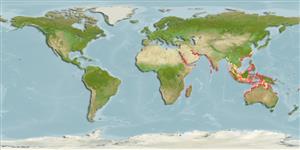Classification / Names
Common names | Synonyms | Catalog of Fishes (gen., sp.) | ITIS | CoL | WoRMS | Cloffa
Environment / Climate / Range
Ecology
Marine; benthopelagic; depth range 0 - 40 m (Ref. 30573). Subtropical, preferred ?
Indo-West Pacific: Red Sea to Gulf of Oman. Nominal records east of Oman need to be confirmed.
Length at first maturity / Size / Weight / Age
Maturity: Lm ?, range 83 - ? cm
Max length : 120 cm WD male/unsexed; (Ref. 8630)
Found inshore (Ref. 9909). Feed on small mollusks and bony fishes (Ref. 12951). Ovoviviparous (Ref. 50449). Utilized where it occurs but information lacking (Ref. 9909).
Life cycle and mating behavior
Maturity | Reproduction | Spawning | Eggs | Fecundity | Larvae
Exhibit ovoviparity (aplacental viviparity), with embryos feeding initially on yolk, then receiving additional nourishment from the mother by indirect absorption of uterine fluid enriched with mucus, fat or protein through specialised structures (Ref. 50449).
Compagno, L.J.V., 1999. Checklist of living elasmobranchs. p. 471-498. In W.C. Hamlett (ed.) Sharks, skates, and rays: the biology of elasmobranch fishes. Johns Hopkins University Press, Maryland. (Ref. 35766)
IUCN Red List Status (Ref. 115185)
CITES (Ref. 94142)
Not Evaluated
Threat to humans
Harmless
Human uses
More information
ReferencesAquacultureAquaculture profileStrainsGeneticsAllele frequenciesHeritabilityDiseasesProcessingMass conversion
Tools
Special reports
Download XML
Internet sources
Estimates of some properties based on models
Phylogenetic diversity index (Ref.
82805): PD
50 = 0.6250 [Uniqueness, from 0.5 = low to 2.0 = high].
Bayesian length-weight: a=0.00692 (0.00223 - 0.02148), b=3.05 (2.80 - 3.30), in cm Total Length, based on LWR estimates for this (Sub)family-body shape (Ref.
93245).
Trophic Level (Ref.
69278): 4.1 ±0.67 se; Based on food items.
Resilience (Ref.
69278): Low, minimum population doubling time 4.5 - 14 years (Fec assumed to be <100).
Vulnerability (Ref.
59153): Very high vulnerability (77 of 100) .
